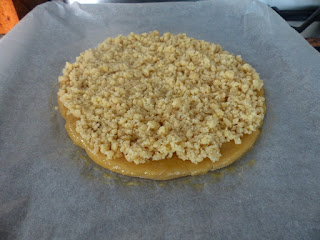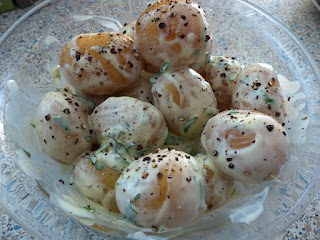The recipe: p32, "Streusel Cake"
During the original Random Kitchen, I dedicated an entire post to this particular book only for it to stubbornly refuse to be chosen even once during the entire project. (How rude.) It's a pleasing bit of timing, then, that we're finally all set to visit the world of Swedish baking just as I'm busy working my way through a lockdown care package from the marvellous Scandinavian Kitchen.
Except we're not. Because, and there are no two ways around this: the randomly chosen recipe this week is German. That's not just food snobbery. Sometimes known as a crumb cake on account of its crumbly topping, Streuselkuchen is unquestionably and undeniably a German speciality. Now, it's true that this book only claims to contain the recipes you need for a perfect Swedish fika, not that they're all Swedish in origin. So while I'm disappointed not to be doling out the pärlsocker just yet, we'll just have to make do with something from slightly further afield.
Even if it's something I already know isn't going to be especially interesting. Or interesting at all, really. Granted, Streuselkuchen is occasionally my cake of choice when life happens to plop me down at the counter of a German bakery, but ideally one with fruit in - apple or some berries, say - to add a bit of much-needed texture and moisture. This particular variant is resolutely fruit-free and looks about as rudimentary as they come.
I wouldn't mind, but the recipe comes from the "Yeast Breads" chapter of the book, which features such genuine Swedish favourites as saffron buns, cinnamon rolls, and even the magnificent seasonal semlor. Still, that's the nature of the random project. And don't worry - there'll still be plenty for me to write about...
The prep: While the aforementioned care package mainly comprised crispbreads, chocolate, various fish products and the obligatory salt liquorice, the Great Flour Shortage of 2020 was still recent enough for me to add a bag of actual Swedish flour to my order. Which means big authenticity points:
Other than that, well, I said the recipe was rudimentary and I wasn't kidding - beyond stocking up on chopped almonds, there's nothing I need to buy here. Which is good, because it means less of a waste of money when things all go wrong.
The making: Milk and butter are heated to the very specific temperature of "37°C, or 45°C if using active dry yeast", which I am. This fine distinction is somewhat arbitrary considering I don't own a food thermometer, but hey - it's not like the temperature is going to be perfectly accurate by the time it all gets mixed together anyway, so I decide to apply a rule of thumb (or rather, forefinger) in judging what constitutes luke-warm liquid for this particular purpose. This may prove to be an error.
The recipe then asks me to crumble in the yeast and dissolve it in the warm milk and butter mixture. The crumbling implies this instruction is for fresh yeast, but it doesn't tell me not to stir in my powdered dry yeast at this point, so in it goes. This may prove to be an error.
I then put some flour in a mixing bowl before stirring in a mere two teaspoons of sugar (this really is a "cake" in nominal terms only), a pinch of salt, half an egg, and the milk/butter/yeast combo. The resulting gloopy mixture is kneaded with a wooden spoon "until smooth and elastic". This seems to happen fairly quickly, so I figure that's probably enough kneading for now. This may prove to be an error.
The rest of the flour is then added. The recipe doesn't tell me to knead it in - it doesn't say anything about mixing it in at all, in fact - but I figure I need something that at least resembles dough by the time this stage is done, so I get to work with my knuckles for a minute or two (making sure to wash my hands first, since I've also been making a batch of Canarian mojo sauce - no one needs traces of chilli and coriander in their Streusel).
This is the end result:
Seems to be a dough, so I cover it for an hour and leave it to rise.
At this point, I hear a whisper in my ear. The whisper is a memory. A memory of when I made those white bread rolls a few weeks ago. James Martin required me to knead the dough for ten minutes, see, and even then it didn't rise quite as nicely as I might have liked. Since this is cake base is essentially a bread too, common sense would dictate that this week's dough would benefit from a similar level of attention. But again, the recipe hasn't actively told me to work the dough especially hard, so I decide not to. This may prove to be an error.
An hour passes. And whatever the error, be it single or cumulative, the fact is that my dough now looks like this:
Ah. That's... that's the same, isn't it?
Bugger.
At this point it's already fairly clear that this project is destined for failure, but what do we do on Random Kitchen when faced with adversity? That's right, we plough on regardless! And so I "lightly knead" my defiantly unrisen dough into a "round, smooth cake" around nine inches in diameter, then leave it to rise for another half an hour.
 |
| Less a cake, more a pancake |
Obviously it doesn't rise any further during this time. Not even a bit. Not even when I decide that our kitchen might be a bit on the cool side - because that's the problem here - and pop the baking tray out in the Saturday sunshine for a while (still covered, of course).
Still, I'm determined to see this through no matter what, so I move on to preparing the titular crumb ("Streusel" loosely translates as crumble(s) or sprinkle(s), fact fans). This involves measuring out some dry ingredients in a mixing jug, because Swedish recipes seem to really hate using scales:
This decilitre-and-a-half of flour, sugar and chopped almonds is rubbed into some butter to form the requisite crumb. The "cake" is then brushed with beaten egg and the mixture is sprinkled on top before it goes into the oven.
I may have a cynical demeanour, but deep down inside I'm something of an optimist. As such, I still hold out some hope that the cake might miraculously rise while cooking. And it does! A little. Unfortunately, the stodgy nature of the dough means the prescribed cooking time is now excessive, so I end up with a somewhat scorched Streusel:
Yeah. Quite aside from the burnt bits, the "finished" cake feels about as dense and heavy as it looks. Still, it would make a quite attractive frisbee, or an effective doorstop.
All in all, it's a bit of a disaster. So of course we have to try some.
The eating: We manage about half a slice each, more out of grim curiosity than anything else. The topping actually isn't bad, even the burnt bits - I suppose you can't go too wrong with sugar and butter - but the main body of the cake is a predictably flat, dense and doughy disappointment.
Now, I really hate food waste - I'm a demon for coming up with unlikely meals to use up whatever's left in the fridge, and we're fortunate in having no particular allergies or intolerances to hold us back on that front. But honestly, I don't think even the birds would bother with this, so into the recycling caddy it goes.
Still, it could be worse - at least I've got some bloggable content out of the experience, and... wait, sorry, what's that?
The making: See, here's the thing. I'm a stubborn sod, and while there are many downsides to that tendency, it does mean I'm determined to get this one right. Or at least less wrong. So I give it another try. (The next day. I'm not that keen.)
I won't bore you with the details, suffice it to say that this time I stir the dry yeast into the flour rather than mixing it with the warm liquid, and I knead the dough for a good ten minutes before leaving it to rise. Lo and behold:
That's more like it.
It's still quite flat and shallow by the time I get to the assembly stage, but the end result is decidedly more risen and less burnt. I then take the executive decision to add some icing sugar to make the whole thing look more interesting (well, "less like rubble on toast", at least).
It's still not especially attractive, but there's only so much you can do with what is effectively a flattish bit of bread with some stuff dumped on top.
The eating: The end result remains a bit on the doughy side, but it is a "yeast bread" as much as it is a cake, so that was to be expected. And it's a damn sight better than what I came up with the previous day. Sure, it's far from decadent - you saw what went into it, we're hardly talking luxury ingredients here - but the combination of the buttery crumble topping and the, well, bready base make for a pleasant enough eating experience.
Was it worth making a second time? Probably not, really - we're still working our way through it some days later, and I suspect it's going to feel like a bit of a chore by the time we get to the last few slices. Though it'll probably work quite well heated up and topped with some ice cream. But then most things do.
I'm willing to give Swedish Cakes And Cookies a pass on this one, though - if only because (a) the cake (when made correctly) is perfectly all right really, (b) it's not actually Swedish, and (c) I've made far better things from within the book's pages before. I'll need it to do better next time though. And ideally give me a wee bit more guidance when it comes to how long I should do things for or whether I need to do them at all. You know, little things like that.
Two-word verdict: Acceptable, eventually.
 The book: Swedish Cakes and Cookies (Sju sorters kakor)
The book: Swedish Cakes and Cookies (Sju sorters kakor)







 The book: Jerusalem (Yotam Ottolenghi and Sami Tamimi)
The book: Jerusalem (Yotam Ottolenghi and Sami Tamimi)








 The book: The Silver Spoon
The book: The Silver Spoon






 The book: Good Housekeeping New Step-by-Step Cookbook
The book: Good Housekeeping New Step-by-Step Cookbook





 The book: The Little Swedish Kitchen (Rachel Khoo)
The book: The Little Swedish Kitchen (Rachel Khoo)










